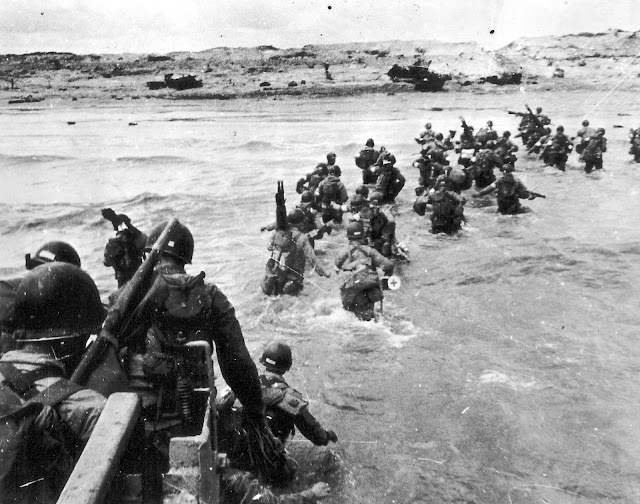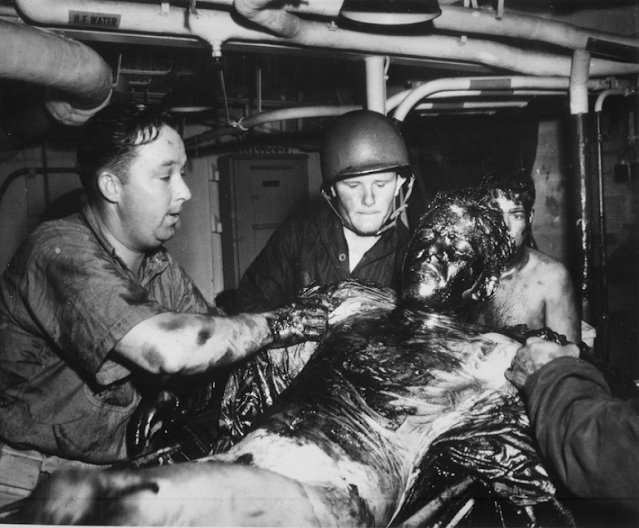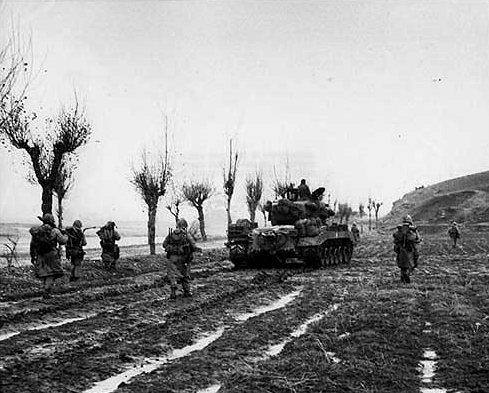CPL. PETER R. ROBINSON: Lost to shadows of time in the Pacific
 |
| George Connors, holding an American flag, rides the American Paint 'Buttercup' at Irvington's May 30, 1958 Memorial Day parade. Village of Irvington officials are seen about a block behind Connors as they enter Main Street from the parking area at today's Main Street School — Irvington High School at the time — where the parade traditionally began. The parade proceeded east on Main to Broadway, then south on Broadway to Dows Lane and Memorial Park. Note the shade cast by the many trees along Main Street at the time, the largest of them elm trees which were decimated in the 1940s-60s and removed after falling victim to Dutch Elm disease. The shorter trees were Norwegian maples, planted by the Irvington Garden Club in the 1940s, '50s and '60s to replace the missing elms. The photographer taking this photo was facing west down Main towards the Hudson River. At left, behind the horse and rider, is the block of buildings known as the Behrens flats between Croton Place and Grinnell Street. Note the huge crowd, typical of Memorial Day parades in the village at tthe time. (Photo courtesy Irvington Public Library, Local History Collection) |
Corporal Peter R. Robertson of the U.S. Army Air Corps has been largely overlooked by his adopted home of Irvington. For reasons unknown, he is listed on the village’s Veterans Memorial Monument at Main Street and Aqueduct Lane as having served in World War II, but is not listed as having given his life for his country.
In fact, he did.
Cpl. Robertson, a son of Scottish immigrants born on July 20, 1926, enlisted as a private in the service, the predecessor of the U.S. Air Force, on Jan. 28, 1945, eight months before war’s end. After spending those months training as a technician to repair and service American B-17 and B-29 bombers, he lost his life in early 1946 when the B-17G Flying Fortress bomber in which he was flying from Saipan to Guam in the Northern Mariana Islands for radio repairs went down and was never found. The trip is a short hop, only about 120 miles. The date of the crash was said to be February, but that's iffy. That date came from a newspaper, not an official War Department statement.
At a monument erected on May 22, 1953 atop an empty grave honoring Robertson and five crewmates at Jackson Barracks National Cemetery in St. Louis, Mo., the date of his death is given as April 2, 1946, apparently that was the date he was declared dead.
A report on the missing flight in an Oregon newspaper states that it involved a B-17 that was listed as missing on April 2, 1946 after it failed to arrive. No date was listed for when the B-17 had been expected to arrive or when it had departed Saipan. The crew were members of the U.S. Army Air Forces 5th Emergency Rescue Squadron apparently based at the former Imperial Japanese Naval Air Base at Atsugi in Occupied Japan.
The Robertson family was not informed until mid-July 1946 that the military had given up the search for Cpl. Robertson and his missing crew mates. All hands were presumed dead.
This prompts the question of why Cpl. Robertson is not among the 16 Irvington residents listed with a star before their names on the Main Street memorial that indicates “Killed in Action.” Before a guess is offered that it’s because he died after war’s end, that’s not the case. The star actually does not mean the soldier was killed in action. It means he served during World War II and died for any reason while still in the service. Irvington resident James Peter Kelley died in 1958 of a fall in his barracks, 13 years after World War II ended, but he has a star next to his name because he served in the Marines in WWII (and Korea) and was still serving in the Marines deployed to Okinawa, Japan when he died.
Another Irvington resident, Lt. Col. George Washington Beavers, enlisted on Aug. 2, 1940 almost a year after Adolf Hitler’s Third Reich attacked Poland to begin World War II, but more than 16 months before the Japanese attack on Pearl Harbor. Beavers died of a heart attack while on a training mission in North Carolina two weeks before Pearl Harbor and is listed on the monument with a star.
So Cpl. Robertson, by all rights, should have a star next to his name on the monument.
The most logical explanation for the absence of a star next to Cpl. Robertson’s name that comes to mind is that his family and friends did not answer calls for corrections and additions to the Irvington memorial veterans list when that list was repeatedly published by the memorial committee in the local Irvington Gazette newspaper.
Robertson, a football player at Irvington High School who graduated in the IHS Class of 1944, is not the only member of that class to lose his life in the service. Classmate Griswold Mills Hill Jr. served in the Marine Corps in World War II and survived the amphibious landing and subsequent hell of the April 1-June 22, 1945 Battle of Okinawa. “M,” as Hill preferred to be known, was discharged from the Marines in 1946 but recalled in 1950 to fight in Korea. He would die on March 1, 1951, cut down by North Korean and Chinese communist forces at the height of the U.S.-led counter-offensive code-named Operation Killer.
James Peter Kelley is listed on Irvington’s memorial monument as a World War II participant, but not as a Korean Conflict participant (he fought in both conflicts). Hill, meanwhile, is not listed on the WWII monument, which he should be, but is listed on the Korean Conflict monument as killed in action in that war.
At least one other Irvington veteran, Peter A. Gorey, fought in both World Wars and thankfully survived. He is listed under both World War I and World War II on the Irvington monument which is dedicated to the 188 World War I Irvington veterans, 465 (plus Hill, we now know) World War II vets from Irvington and the 41 Korean Conflict veterans from the village.
Interestingly, Gorey and fellow World War I veteran Frank P. Murphy of Irvington were the men chosen by Irvington's mayor to put together the list of Irvington veterans who appear on the Main Street monument which was dedicated in time for Veterans Day, 1963. Gorey and Murphy were each one-time commanders of Irvington Post 2911 of the Veterans of Foreign Wars. Post 2911 met at 31 North Eckar Street in the first floor and finished basement of the building that housed the Robertsons' apartment. The Irvington Veterans Memorial Association Inc., the incorporated identity of the VFW Post, purchased the building from the defunct Pastime Club in 1951, five years after Cpl. Robertson was lost.
Cpl. Robertson’s parents, Robert Thomson Robertson and Jessie Leggett (Morrison) Robertson, emigrated from Scotland to the U.S. in 1923. Robert was 23 at the time and Jessie 26. The couple married in 1925 and settled in Yonkers where Robert found work as a machinist in the world’s largest carpet mill of the time, the Alexander Smith & Sons Carpet Co. mills in Yonkers which date to 1871.
The family lived in company housing provided by the mill owners near today’s Getty Square in Yonkers.
The mill employed many immigrants, mainly Scottish, Irish and Ukrainian.
 |
| This is the original Irvington war monument on Main Street near Aqueduct Lane c. 1955. It was replaced with a bronze plaque on granite monument in advance of Veterans Day in 1963. |
Young Peter had come along on Nov. 27, 1926 and George Morrison Robertson, the Robertsons’ second and final child, would be born in 1931.
By 1934, the Robertsons had moved to Irvington, dad Robert finding work at the General Motors factory in North Tarrytown (Sleepy Hollow today, site of today’s Edge-on-Hudson condominiums). Peter would enter Irvington High School in September 1940. At IHS he played football on both offense and defense as was customary at the time. He played fullback on offense and most likely linebacker or perhaps line on defense.
After graduating Irvington High in June 1944, but before he turned 18, Peter joined the Westchester Squadron of the Civil Air Patrol as a cadet and visited the U.S. Army’s Mitchel Field on Long Island in July 1944. The decommissioned site is now the home of Nassau Veterans Memorial Coliseum, some seven miles east of Queens. A story in the local Irvington Gazette newspaper about the trip said the cadets were getting a taste of army life that they’d fully encounter whenever called to active duty after their 18th birthdays. Robertson would have turned 18 on July 20, 1944.
Cpl. Robertson was stationed at Amarillo (Texas) Army Air Field after his enlistment. That is where he likely trained as a technician for repairs and servicing of B-17 Flying Fortress and B-29 Superfortress bombers.
After completing his training in Amarillo, young Robertson, still 18, took leave from the end of September through the first two weeks of October 1945 to visit Irvington before departing for a new assignment at Ogden (Utah) Air Depot’s Hill Field about 30 miles from Salt Lake City, a center for aircraft repair and refurbishment.
 |
| Irvington Boy Scout and Cub Scout troops march in the May 30, 1958 Memorial Day Parade on Main Street heading to Broadway. (Photo courtesy Irvington Public Library, Local History Collection) |
It’s still not clear when, why or how Cpl. Robertson wound up in the Philippines or even if that was only a stopover on a flight from Hill Field to Occupied Japan. His final days and his end are shrouded in mystery. He was 19 when he died.
EPILOGUE: Records are kept by date, location and number of fatalities of B-17G Flying Fortresses and B-29 Superfortresses of the type on which Cpl. Robertson would’ve flown his final fateful mission, but none appear to coincide with his ill-fated flight.
… Peter Robertson’s parents both lived out their days in Irvington, both dying in 1973. His brother George died in Orange, California, at age 51 in 1983. …
AUTHOR’S NOTE: It was only through the personal recollection of a reader of this blog, Kathy (Gallagan) Mahoney, that Peter Robertson’s inclusion has come about. Kathy, an Irvington native with long roots in the village (her maternal grandmother, Elizabeth McGovern was born in Irvington in about 1869), lived on south and later north Dutcher streets before her 1965 marriage. At the time this post was published, she was retired and living in Tappan, N.Y. She said was a regular visitor to nearby Piermont, directly across the river from Irvington where the pre-Tappan Zee Bridge ferry once coursed, where she can look directly at Main Street. Kathy said she never knew Peter Robertson, but did know his five-year-younger brother George in high school and heard stories about the fallen war hero …
... It was also Kathy’s inquiry about Irvington residents who died in the Korean War — or conflict or police action, your choice — that led me to discover yet another Irvington World War II veteran who died in service, albeit 1951 in southern Korea, Pfc. Griswold Mills “M” Hill Jr. … His profile has been added to my blog, joining Peter Robertson’s, bringing to a total of 18, not the previous 16, who came from Irvington, served in the World War II era and died while still in service to their country. ... Hill left the military in 1946 but remained on active reserve duty with the Marines before his 1950 recall. ...
Links to similar personal stories about Irvington heroes who gave their lives for their country*
◼ Pfc. Cuthbert Powell Sinkking: Class of '42 gave 3 of its own to the ages
◼ Pfc. John Joseph (Joe) Gilchrist: Died after capture of Saint-Lo
◼ Lt. (j.g.) George Eddison Haines: Lost at sea, awarded Silver Star
◼ Pfc. Joseph Thomas Costello: Teen lost life in Battle of Mindanao
◼ MSgt. James Peter Kelley: Survived WW II and Korea; died in fall
◼ S1 Archibald Ronald: Lost on next-to-last Navy ship sunk by U-boat
◼ TSgt. Raffaele R. (Ralph) Reale: A hero's life ended on East Sunnyside Lane
◼ Sgt. Robert F. Morrison: Took fight to the enemy, fell in Alsace
◼ Lt. Col. George W. Beavers Jr.: Re-upped as private; died on war's eve
◼ F2 Claude L. Bronnes: Went down with the Atlanta at Guadalcanal
◼ MMLC William James Downey: Died aboard ship off West Coast
◼ Pvt. Alick Main Ian: Died taking Aachen, first German city to fall in WWII
◼ Pfc. George Mills Hill Jr.: Survived Okinawa, only to fall in South Korea
◼ Cpl. Peter R. Robinson: Lost to shadows of time over Pacific, answers never found













Comments
Post a Comment